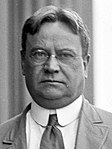This article needs additional citations for verification. (May 2023) |
| |||||||||||||||||||||||||||||
940 delegates to the 1920 Republican National Convention 471 (majority) votes needed to win | |||||||||||||||||||||||||||||
|---|---|---|---|---|---|---|---|---|---|---|---|---|---|---|---|---|---|---|---|---|---|---|---|---|---|---|---|---|---|
| |||||||||||||||||||||||||||||
| |||||||||||||||||||||||||||||
From March 9 to June 5, 1920, voters of the Republican Party elected delegates to the 1920 Republican National Convention for the purpose of choosing the party's nominee for president in the 1920 election.
The delegates were largely contested between Governor Hiram Johnson of California, a progressive who had been the running mate of Theodore Roosevelt eight years prior; General Leonard Wood, one of Roosevelt's closest friends; and Frank O. Lowden, the Governor of Illinois.
After a series of primary elections and caucuses, no candidate had emerged with a clear majority of the delegates. At the 1920 Republican National Convention, held from June 8 to June 12, in Chicago, Illinois,[1] the delegations of the leading candidates deadlocked and Warren G. Harding was nominated as a dark horse candidate, although he had only won a few delegates entering the convention.
Cite error: There are <ref group=lower-alpha> tags or {{efn}} templates on this page, but the references will not show without a {{reflist|group=lower-alpha}} template or {{notelist}} template (see the help page).
- ^ Kalb, Deborah (February 19, 2016). Guide to U.S. Elections - Google Books. CQ Press. ISBN 9781483380353. Retrieved February 19, 2016.




